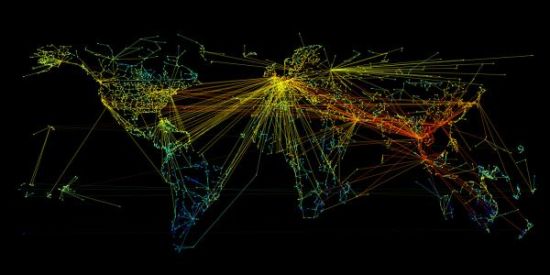Communications of the ACM
Technology on Way to Forecasting Humanity's Needs, Researcher Reports

"Using network theory, mathematical biology, statistics, computer science and nonequilibrium statistical physics will play a key role in the creation of computational forecasting infrastructures," says Indiana University Professor Alessandro Vespignani.
Courtesy of Indiana University
Much as meteorologists predict the path and intensity of hurricanes, Indiana University's Alessandro Vespignani believes we will one day predict with unprecedented foresight, specificity and scale such things as the economic and social effects of billions of new Internet users in China and India, or the exact location and number of airline flights to cancel around the world in order to halt the spread of a pandemic.
In the July 24 issue of the journal Science, Vespignani writes that advances in complex networks theory and modeling, along with access to new data, will enable humans to achieve true predictive power in areas never before imagined. This capability will be realized as the one wild card in the mix — the social behavior of large aggregates of humans — becomes more definable through progress in data gathering, new informatics tools and increases in computational power.
Vespignani is the James H. Rudy Professor of Informatics and adjunct professor of physics and statistics at IU, where he is also the director of the Center for Complex Networks and Systems Research (CNetS) at IU's Pervasive Technology Institute and the IU Bloomington School of Informatics and Computing.
Researchers have already shown they can track the movement of as many as 100,000 people at a time over six months using mobile phone data, and use worldwide currency traffic as a proxy for human mobility. There are sensors and tags generating data at micro, one-to-one interaction levels, much as Bluetooth, Global Positioning Systems and Wi-Fi leave behind detailed traces of our lives.
Such are some of the new sources of basic information that researchers are using to gain knowledge about aggregated human behavior. This new "reality mining" should in turn enhance the ability of researchers and scientists to accurately forecast the effects of phenomena like catastrophic events, mass population movements or invasions of new organisms into ecosystems, Vespignani said.
"It is analogous to what happened in physics when we saw the shift from the study of atomic and molecular physics to the study of the physics of matter," he said. "Here we see a movement from the study of a small number of elements, or small social groups, to the study of the behavior of large-scale social systems consisting of millions of people that can be characterized in space, both social and geographic, and in time."
 This epidemic invasion tree identifies 3,200 separate population nodes worldwide linked to theH5N1 avian flu pandemic of 2000-04 that originated in Hanoi. Time ordering of the epidemic'smovement is displayed from the earliest paths in dark red, moving to light red, green and blue as time progress. Courtesy of Indiana University This epidemic invasion tree identifies 3,200 separate population nodes worldwide linked to theH5N1 avian flu pandemic of 2000-04 that originated in Hanoi. Time ordering of the epidemic'smovement is displayed from the earliest paths in dark red, moving to light red, green and blue as time progress. Courtesy of Indiana University |
Quantifying effects of risk perception and awareness phenomena among individuals on the larger techno-social network's structure and dynamics needs to be designed into formal models, he added, and a need remains for the deployment of monitoring infrastructures capable of supplying real time information to computational models.
"While the needed integrated approach is still in its infancy, using network theory, mathematical biology, statistics, computer science and nonequilibrium statistical physics will play a key role in the creation of computational forecasting infrastructures," Vespignani said. "And that should help us design better energy distribution systems, plan for traffic-free cities and manage the deployment of the world's resources."
No entries found